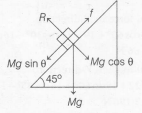Answer:
Option A
Explanation:
Given that

$\mu= Cs^{2}$ [ $\because$ s= distance and C = constant ]
net force on the block is

$Mg\sin \theta- f=Ma$
$ Mg sin \theta - \mu Mg \cos \theta=Ma$
$g \sin \theta- \mu g \cos \theta$=a
$g[\sin \theta -Cs^{2} \cos \theta]=a$ ..........(i)
$\because$ $a= \frac{dv}{dt}=v \frac{dv}{ds}$
$ads=vdv$ ...........(ii)
From eqs.(i) and (ii) , we get
$\Rightarrow$ $g[\sin \theta-Cs^{2} \cos \theta ]ds=vdv$
Integreating both sides , we get
$\Rightarrow$ $(g\sin\theta)s-g\frac{Cs^{3}}{3}\cos\theta=\frac{v^{2}}{2}+K$ .....(iii)
For $\theta=45^{0}$, we have
$\left(\frac{g}{\sqrt{2}}\right)s-\left(\frac{Cs^{3}}{3}\right)\frac{g}{\sqrt{2}}=\frac{v^{2}}{2}+K$
Initially t=0, s=0 ,u=0 substitutingthese , we get k=0
So, $\frac{g}{\sqrt{2}}\left(s-\frac{Cs^{3}}{3}\right)=\frac{v^{2}}{2}$
$\Rightarrow s-\frac{Cs^{3}}{3}=\frac{v^{2}}{2}\times \frac{\sqrt{2}}{g}$
The body stops, when v=0 $\Rightarrow s-\frac{Cs^{3}}{3}=0$
$\Rightarrow$ $s= \frac{Cs^{3}}{3}\Rightarrow s=\sqrt{\frac{3}{C}}$